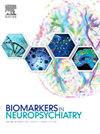Cognitive performance and differentiation of B-SNIP psychosis Biotypes: Algorithmic Diagnostics for Efficient Prescription of Treatments (ADEPT) - 2
Q2 Medicine
引用次数: 0
Abstract
Objective
The B-SNIP consortium validated neurobiologically defined psychosis Biotypes (BT1, BT2, BT3) using cognitive and psychophysiological measures. B-SNIP’s biomarker panel is not practical for most settings. Previously, B-SNIP developed an efficient classifier of Biotypes using only clinical assessments (called ADEPT-CLIN) with acceptable accuracy (∼.81). Adding cognitive performance may improve ADEPT’s performance.
Method
Clinical assessments from ADEPT-CLIN plus 18 cognitive measures from 1907 individuals with a B-SNIP psychosis Biotype were used to create an additional diagnostic algorithm called ADEPT-COG. Extremely randomized trees were used to create this low burden classifier.
Results
Total Biotype classification accuracy peaked at 94.6 % with 65 items. A reduced set of 18 items showed 90.5 % accuracy. Only 9–10 items achieved a one-vs-all (e.g., BT1 or not) accuracy of ∼.95, considerably better than using clinical assessments alone. The top discriminators of psychosis Biotypes were antisaccade proportion correct, BACS total, symbol coding, antisaccade correct response latency, verbal memory, digit sequencing, stop signal reaction times, stop signal proportion correct, Tower of London, and WRAT Reading. Except for antisaccade proportion correct and Tower of London, there was no overlap of the top discriminating items for B-SNIP Biotypes and DSM psychosis categories.
Conclusions
This low-burden algorithm using clinical and cognitive measures achieved high classification accuracy and can support Biotype-specific etiological and treatment investigations in clinical and research environments. It may be especially useful for clinical trials.
B-SNIP 精神病生物类型的认知表现和区分:高效治疗处方算法诊断(ADEPT) - 2
目标B-SNIP联盟利用认知和心理生理测量方法验证了神经生物学定义的精神病生物类型(BT1、BT2、BT3)。B-SNIP 的生物标记物面板在大多数情况下并不实用。此前,B-SNIP 仅使用临床评估(称为 ADEPT-CLIN)就开发出了一种高效的生物类型分类器,其准确性可接受(∼.81)。方法使用 ADEPT-CLIN 的临床评估结果和 1907 名 B-SNIP 精神病生物类型患者的 18 项认知测量结果,创建名为 ADEPT-COG 的附加诊断算法。结果65个项目的Biotype总分类准确率达到94.6%。减少 18 个项目后,准确率为 90.5%。只有 9-10 个项目的单项对全项(如 BT1 或非 BT1)准确率达到了 ∼.95,大大高于仅使用临床评估的准确率。对精神病生物类型的判别能力最强的是反施法正确率、BACS总分、符号编码、反施法正确反应潜伏期、言语记忆、数字排序、停止信号反应时间、停止信号正确率、伦敦塔和WRAT阅读。除了反施法正确率和伦敦塔外,B-SNIP 生物类型和 DSM 精神病类别的最高判别项目没有重叠。结论这种使用临床和认知测量的低负担算法达到了很高的分类准确性,可以支持临床和研究环境中针对生物类型的病因学和治疗调查。它可能对临床试验特别有用。
本文章由计算机程序翻译,如有差异,请以英文原文为准。
求助全文
约1分钟内获得全文
求助全文
来源期刊

Biomarkers in Neuropsychiatry
Medicine-Psychiatry and Mental Health
CiteScore
4.00
自引率
0.00%
发文量
12
审稿时长
7 weeks
 求助内容:
求助内容: 应助结果提醒方式:
应助结果提醒方式:


